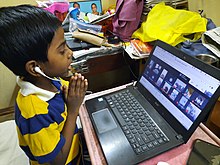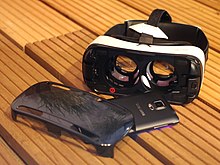– Vagish K Jha
“Technology can amplify great teaching, but great technology can’t replace poor teaching.” The above sentence is straightforward, instructive, and specious or half-truth. Let us examine them one by one.
Just as the sudden outbreak of COVID snuffed life out of vibrant schools all over the world, technology emerged as the savior. Teachers rode the bandwagon of technology en masse. Online teaching became the norm. Teachers put up a valiant front and made classes ‘live’ in their online avatar. They delivered their class sitting in front of their mobile or pressing buttons of apps like WhatsApp. Technology helped replicate schools and reach children’s homes.

It may not be an exaggeration to say that schools survived the possible extinction because of technology. So, the first part of the opening statement is bang on the target – Technology amplifies. This was the beginning of the online story of teaching.
As time passed, some uncomfortable realizations began to surface. The majority of teachers had one standard complaint about online teaching – ‘we don’t know if students are engaged or learning in an online setup’. The lively students turn into stamp-size entities on the screen. Apart from the issue of internet bandwidth, teachers can’t ascertain if learning is happening in the online mode. It soon dawned that technology is just the tool, not the learning outcome. We realized that it is the teacher who teaches, not the technology. Now that schools are up and running again, the common refrain has gained ground that there is no alternative to face-to-face teaching.

Such an understanding has a basic problem. It assumes that ‘real teaching’ happenes when students are sitting in the classrooms. The reality, every classroom teacher knows, is far from it. Just because students are sitting in front of you; just because you can see them physically, does not mean that they are engaged with what you are teaching.
Let there be no confusion. Engagement of students has nothing intrinsic to do with the mode of teaching. Online or offline, modes don’t matter. It is pedagogy, the method of teaching, that is crucial for engagement and achieving learning outcomes. A good teacher, there would be broadly a consensus, makes the process of teaching engaging and interactive in a way that students take more and more responsibility for their own learning.
Four pillars of learning
Stanislas Dehaene in his recent book[1] points out attention, active engagement, error feedback, and consolidation as the four pillars of learning. From this perspective, to ensure learning a teacher needs to present a topic such that learners view it as relevant and interesting. Secondly, a teacher needs to create students’ stake in learning by involving them to generate their own hypotheses, formulate arguments to back them, defend conclusions; all of which motivate learners to take up the onus of learning. It is here that teachers can give feedback in terms of possible errors to support them to reach a consistent and valid conclusion or answer. And finally, she can present learners with the opportunity to practice and revisit their learning to consolidate it into their long-term memory.

As is clear, in the above process the mode of learning, online or face-to-face, does not matter. To achieve meaningful learning outcomes, a teacher needs to look carefully into her pedagogy to include the above four key ideas. Shorn of these, it makes bad teaching and technology will not help either. This is the instructive part of the sentence this article opens with.
But why could it be seen as specious or a half-truth? It is so because it takes a one-dimensional and dated view of technology. Let me explain.
Technology opens new possibilities.
The view that technology is just a medium or a conveyer belt, so to say, is to miss a crucial point that the way a teacher teaches is impacted by the technology she uses to teach. Technology opens the pedagogical possibilities for teachers in all the four areas discussed above and much more. Technology today offers immense possibilities to help create learning triggers that can grab attention and tap on student engagement. Technological tools and apps have opened multiple ways to represent learning resources and offer avenues for learners to get actively engaged in the process of learning.
What used to be a drab black and white blurred picture in a corner of a textbook, has now turned into a live tour of Ajanta caves for the students. They can make interesting models of the relevant topic. They can watch amazing videos, understand the mechanism of electromagnetic current with interactive animations on online laboratories. The University of Colorado, for example, provides an amazing array of such simulations.
A teacher can show the flower of daffodils online to children while teaching the poem of the same name by Wordsworth for them to see and experience why the poet is singing a paean to the beauty of this flower. Students may be able to identify similar looking flowers in their own context to relate more deeply with the poem. From very creative and graphic adaptations of a drab text to the vivid visuals or interesting animations, exciting simulations, and immersive technologies of AR, VR, and MR, students today can engage with any or many of them as they try to make a deeper sense of the topic they are learning.

What is exciting about the digital tools is not the plethora of resources it offers but the fact that teachers can modify or contextualize them. The most important thing is that a number of inspired teachers rather than becoming mere consumers have opted to become the producers of their own resources. Resources suitable to the context and the level of students can be created with simple and easily available technology and gadgets like mobile phones. These all result in a high level of engagement and buy-in from students, making the learning processes meaningful and highly relatable.
Similarly, technology today offers myriad ways for students’ expressions to be incorporated into the process of teaching.
Multiple avenues of engagement
The multiple avenues of engagement created by teachers take two routes. One, she offers multiple opportunities to students to express themselves in the process of learning. There is a healthy to and fro. A creative conversation is established in making the teaching-learning processes more meaningful. Digital platforms create a ‘real classroom feel’ in which children can raise their hands to ask questions or voice their views and opinions, write in a chat in real-time so that the teacher can see and respond to, get into group work through breakout rooms and present their views more creatively and in varied ways.
The teacher can give video assignments or a podcast for deeper engagement and amazingly varied assessments. Learners can just not write in their physical notebooks, but also make their own videos, animations, mind-maps, and their own e-profiles to demonstrate their involvement, understanding, engagement and to consolidate their learning. Those who miss out on these opportunities offered by digital technology are left behind not just on the professional front but also in the hearts of the learners in major ways. This is what differentiates an inspired teacher from an average one.

As we have tried to spell out, technology is not only an amplification medium but an impactful enabler of quality learning. A good tool reduces the energy investment in tasks and, thus, makes it more efficient.
“Raising intelligence in the human lineage”, notes A. C. Grayling, ‘is intimately connected with tools – Technology”[2]. We also promptly need to remind ourselves, as Theodor Adorno remarked, that humanity has grown cleverer over time, as evidenced by the development of spear into a guided missile, but no wiser, as evidenced by the guided missile itself.
In the space of learning, it is important to be alert and understand that technology and pedagogy have a dialectical relationship. We shape the tool and they, in turn, shape us the way we do things. A good teacher today must know how to make wiser choices of technology to further her pedagogical approach to achieve the curricular outcomes and more importantly to put learners on the path of being self-directed learners.
References:
[1] Stanislas Dehaene, How We Learn: Why Brains Learn Better Than Any Machine for Now, Viking, 2020
[2]A. C. Grayling, The Frontiers of Knowledge: What We Know About Science, History and The Mind, Penguin, 2021